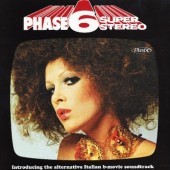Around the mid-sixties, orchestra director Armando Sciascia began his activity as a producer and editor by creating the Vedette record label, and together with a group of friends and musicians began to produce soundtrack material for films, documentaries and TV shows. By the end of the sixties Vedette had begun to market their recordings, releasing records like the Phase 6 Super Stereo series, to which our compilation "Phase 6 Superstereo" pays tribute. Vedette's productions were inspired by the diverse musical style of those years, experimenting unusual and bizarre arrangements of classic songs like Fred Buscaglione's "I Found My Love In Portofino" covered by Billy and Friends and featuring electric sitar, and contaminating various genres and arrangements with original compositions of notable substance. Another fundamental aspect of Sciascia's and his collaborators work is the great attention payed to the technical side of of recording and mixing the tracks, experimentings innovative studio techniques and sounds. Phase 6, for example, takes it's name from a complex system of stereo recording that involves phase and couter phasing. Sergio Sciascia, Armando's son, recalls: "They were crazy, they'd take the studio to pieces trying to get the best acoustics when mixing a track, whith a combination of professionalism and lust for experimental research." All this, and sounds to accompany erotic and psychedelic sequences with a trubine of darm and mysterious rhythms, together with a particular choice of covers, make Vedette's recordings easily recognizable. -- taken from Phase 6 Super Stereo LP (Plastic Records PL005)
Sexy ad Alta Tensione, Mondo Caldo Di Notte, Europa, Operazione Streap-Tease, Per Una Valigia Piena di Donne, Sexy: these are a few films from the 1960's that had an enormous power to draw the audiences in under their perverse guise, packing the cinema houses even in the middle of the day right up until the late show. But why were these films so successful, (which were more like film ettes, and nothing more) without a plot, story, and all lacking in real content? If it weren't for our empty pockets, who wouldn't have splurged on a plane ticket to Paris, mythical world capital of the strip tease? The only possible alternative was to head to the movies in pursuit of sexy transgression, where there, in the comforting dark of the theatre, as the film would begine (in this case, "Mondo Caldo Di Notte") our senses were incited by the sounds of Armando Sciascia's orchestra and his enchanting "Modern Prelude." The opening scene reveals the maestro himself, a rather rare case in cinematography, and it is truly an hommage to the artist, as he stylishly directs his precious soloists. It is in fact much more than a "Modern Prelude" but also a lesson in elegance and class. On top of the absence of shadow during the pornography, there is the desecrating and almost ironic play-by-play narration describing the images for what there are, good heartedly naughty slices of life from nightclubs and other gatherings points on the planet. And yes its true, there was the recondite possibility of "getting a glimpse" every now and again of the shadow of a breast, (no small thing in the 60's!) as in "La Donna di Notte," when the stripper turns and suddenly reveals for a whole second and a half, her nipples just as the light comes up in the movie theatre. The spectators, of course would break into an uproar shouting as if at the soccer stadium while other "supporters" and "aficionados" in the crowd would give a five minute applause. I still remember it all vividly after almost 35 years!
Streap-teases, magicians, singers, and beautiful music, the exhibitions of Dodo d'Amburgo, Rita Cadillac and other glimpses of the fabulous "Crazy Horse," it was always to our dismay that balloons and shooting stars hid the breasts, the thighs, and the asses. The censors at the time alwasy covered up the best stuff (I do recall, however once in an episode of an Italian documentary on an island in the Tropics, the censors failed to cut the several meters of the film in which, you could.ever so slightly - granted you had 20/20 vision - catch sight of a crotch! (Mamma mia!!!). The did succeed however, in "covering" every single copy of the film arlready distributed to the theatres - certainly a very menial and patience requiring task (involving the handy magic marker). Inevitably the film would come to and end, with Sciascia concluding his cinematographic concert with the most beautiful "pedale di fiati" that he had ever written, and for us there was nothing left to do but to head home, satisfied, even if a little melancholy. Then, at home, where the magic of imagination, fantasy, and above all the music of the records, it became possible for the "journey" to continue. There was the miracle of returning to Paris, Hamburg, Tokyo and all the world's grand capitals, where the women of our dreams, perhaps with a naughty wink of an eye, would promise us a truly unforgettable night. -- Written by Roberto Zamori, translation by Genevieve Maull.
taken from Mondo Caldo di Notte CD (Plastic Records PL009)
